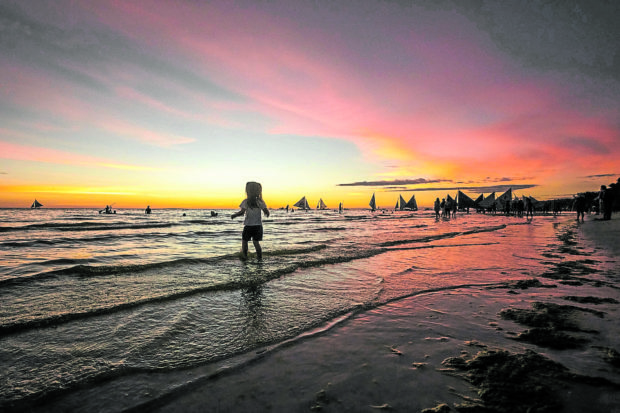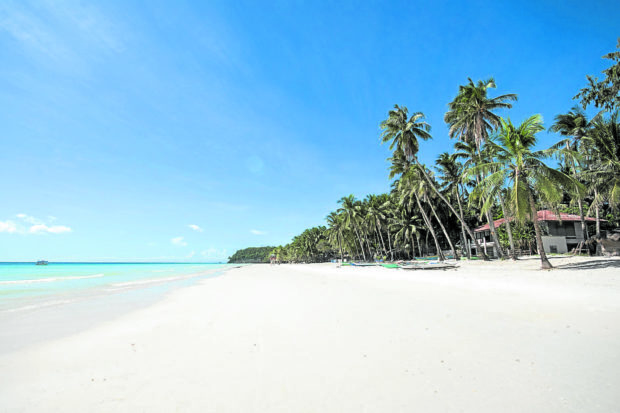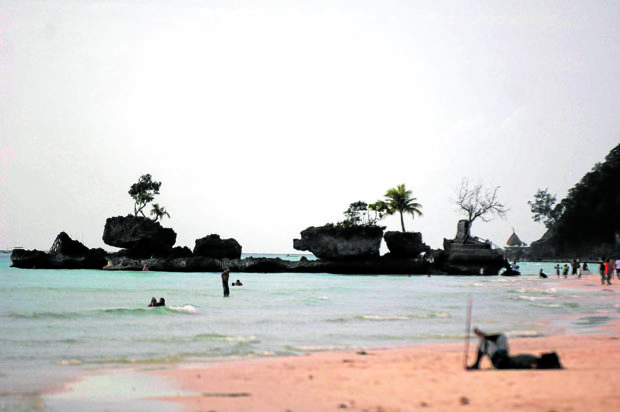Boracay sinks in pandemic

PIECE OF PARADISE In this file photo, tourists enjoy Boracay Island’s white sand beach and spend moments of silence as they watch the setting sun from this piece of paradise in Malay, Aklan. The coronavirus pandemic, however, has hit Boracay hard, as visitors, who fuel the local economy, stopped coming. —INQUIRER PHOTO
For the past weeks since Boracay began its lockdown, Kenwalt Talorong has been selling barbecues near the deserted beachfront. His earnings — P150 to P200 a day — sustain him and his partner.
“It’s just enough for us to survive until the lockdown is over and we can go home,” the 33-year-old breadwinner said. His 7-year-old twin sons and 3-year-old daughter are in Manila with his partner’s family.
Less than two months ago, Talorong was head chef of a Japanese restaurant at Station 1, a busy tourist strip on the northern part of Boracay in Malay, Aklan. When the restaurant stopped operating on March 19 as cases of the new coronavirus disease (COVID-19) started to climb in the country, he and other workers were stranded on the resort island due to travel restrictions.
“We have no income, but it would have been bearable if our family is together,” he said.
The owner of the Japanese restaurant had told Talorong and the other workers that the establishment would unlikely to resume operations within the year due to the expected slump in tourism.
Article continues after this advertisementAfter 11 years of working in Boracay, Talorong said he planned to go back to Metro Manila if the situation would not improve.
Article continues after this advertisementWorse than 2018
The pandemic has hit Boracay, the country’s prime tourist destination, hardest, with most establishments closed and swimming along its famous white sand beach banned.
“This is worse than the closure because back then, we knew that we will be back to normal after six months,” said Elena Brugger, president of the Philippine Chamber of Commerce and Industry-Boracay.
Brugger was referring to the closure of the island to tourists from April 26, 2018 to Oct. 25, 2018, as Boracay underwent environmental rehabilitation.
She said losses to businesses had reached “billions of pesos,” worsening the impact brought about by the 2018 shutdown, Taal Volcano’s eruption in early January when fewer visitors came, and Typhoon “Ursula,” which ravaged the island in December 2019.
“It’s really bad. This time, nothing is certain until a [COVID-19] vaccine is developed. We don’t know if travel will normalize in 12 months, two years, or more,” she said.
Brugger said businesses, especially small establishments and their workers, desperately needed help as many of the 20,169 regulars had not received assistance from the Department of Labor and Employment’s (Dole) COVID-19 Adjustment Measures Program (CAMP).
The Dole in Western Visayas reported that 153 establishments, with 4,864 employees, in Boracay had availed themselves of the P5,000 per worker in CAMP assistance. The agency, however, said it was unable to provide assistance to other workers due to depleted funds.
Tourism revenue from Boracay tourists reached P62.31 billion in 2019, according to data from the Department of Tourism (DOT). In 2017, P357 million, or about 90 percent of locally sourced revenue of Malay came from Boracay, comprising of fees from business and building permits, and environmental and terminal fees.
Tourist arrivals in Boracay reached 2,034,599 in 2019, including 1,037,619 foreigners. From 167,070 in January this year, the number dropped to 103,834, or 37.85 percent lower in February.

PICTURE PERFECT Boracay’s white beach has been quiet in the past two months due to travel restrictions imposed by the government to stop the community transmission of COVID19. —JACK JARILLA/CONTRIBUTOR
Priority
Aklan province is among the areas categorized by the Inter-Agency Task Force on Emerging Infectious Diseases (IATF-EID) as “low-risk” for coronavirus transmission. From May 16 until May 31, Boracay will be placed on general community quarantine.
Acting Malay Mayor Frolibar Bautista said the local government was still waiting for guidelines from the IATF-EID. “Leisure activities, including tourism, are the last to reopen. We cannot still say when we can allow tourists to go to Boracay,” he said.
Even with the lifting of community quarantine measures, residents and business owners do not expect that they will recover soon.
Brugger cited the need for strategy so that Boracay could recover from mounting economic losses. “We are still waiting for guidance from the DOT and other government agencies, but our priority now is the health and safety of the community,” she said.
Business operators are realistic in setting expectations.
“I don’t think we will get any tourists soon. I have canceled bookings up to November and our focus is staying alive until December,” said Julia Lervik, who co-owns a cafe and resort villas for rent.
She said that unlike in October 2018, when many tourists were excited and looking forward to go back to the island when it reopened, global travel restrictions and reduced earnings would continue to dampen tourism travel.
“People in general will still be afraid to travel [because of the absence of a vaccine]. We are figuring out how to keep our staff because we don’t want to abandon them,” she said.
According to Lervik, they will adopt reduced workdays and hours for their employees until tourists come back and their operations normalize.

Before the lockdown, the beach area near Willy’s Rock on Station 1 attracted tourists for the perfect Boracay shot. —JACK JARILLA/CONTRIBUTOR
No alternative
She said the 1,032-hectare island had no real alternative if tourists would not return.
While restaurants and other businesses are now relying on locals and stranded tourists to sustain their businesses through food deliveries and pickup, business operators see this as not enough. Many small establishments are expected to shut permanently.
Amid the lockdown, business owners and nongovernmental organizations on the island have been helping residents through food distribution activities.
“We are trying to help each other, but we cannot sustain our efforts if we do not earn,” Lervik said.
Jose Clemente III, president of Tourism Congress of the Philippines, said the recovery of tourism activities in destinations like Boracay would depend on policies of local governments on health and travel restrictions.
“Everyone is looking at the domestic market but it will take time for people to get comfortable, or feel safe. Tourists will consider safety and health measures adopted by establishments,” he said.
Longtime Boracay resident David Goldberg, who operates a deli with his business partners, said that with the lifting of quarantine measures, local tourists could be gradually allowed to come in.
But he said this must be premised on upgrading hospitals and health centers on the island with more isolation rooms, including the setting up of a subnational laboratory for COVID-19 tests.
“We all know the virus will not go away. We should have the capacity to conduct mass testing and tracing, and need not send test samples to [the capital town of] Kalibo and Iloilo City [in Iloilo province]. Otherwise, people will be hesitant and it will take only one infected person here to drive away tourists,” Goldberg said.
For more news about the novel coronavirus click here.
What you need to know about Coronavirus.
For more information on COVID-19, call the DOH Hotline: (02) 86517800 local 1149/1150.
The Inquirer Foundation supports our healthcare frontliners and is still accepting cash donations to be deposited at Banco de Oro (BDO) current account #007960018860 or donate through PayMaya using this link.
